Why should i use landing pages?
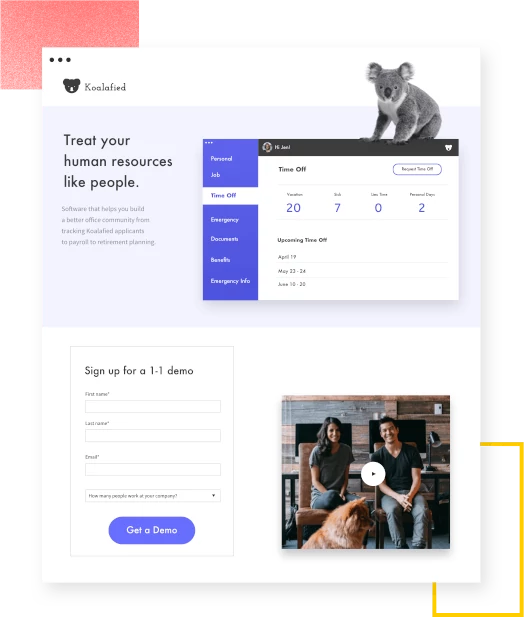
In digital marketing, a landing page is a standalone web page, created specifically for a marketing or advertising campaign. It’s where a visitor “lands” after they click on a link in an email, or ads from Google, Bing, YouTube, Facebook, Instagram, Twitter, or similar places on the web.
Unlike web pages, which typically have many goals and encourage exploration, landing pages are designed with a single focus or goal, known as a call to action (or CTA, for short).
It’s this focus that makes landing pages the best option for increasing the conversion rates of your marketing campaigns and lowering your cost of acquiring a lead or sale.
Here’s where landing pages might fit into your marketing funnel:
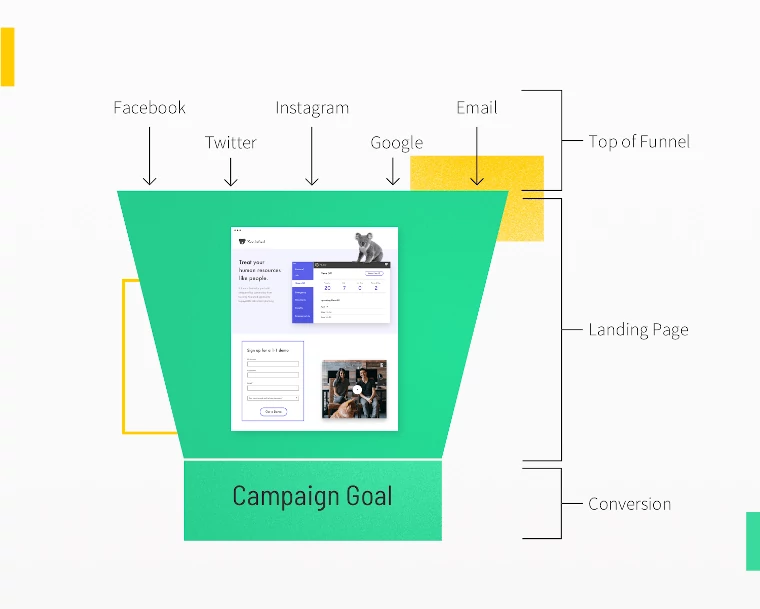
As you can see, the landing page exists after prospects at the top of the funnel click a link in an ad, email, or anywhere else on the web. It’s where the conversion (like a purchase, signup, or registration) will take place.
Q. Wait, can’t any page be a landing page?
Technically, sure. The term is used this way in Google Ads and Analytics, for instance. But not all destination pages are made equal. At Unbounce, we use the term “landing page” to describe a campaign-specific page with just one single call to action and no website navigation.
The Key Difference Between a Homepage and a Landing Page
(or Why Landing Pages Are So Freakin’ Good at Converting)
Below we’ve got a homepage and a landing page laid out side by side. See how the homepage has tons of links and the landing page has only one? That’s pretty typical.
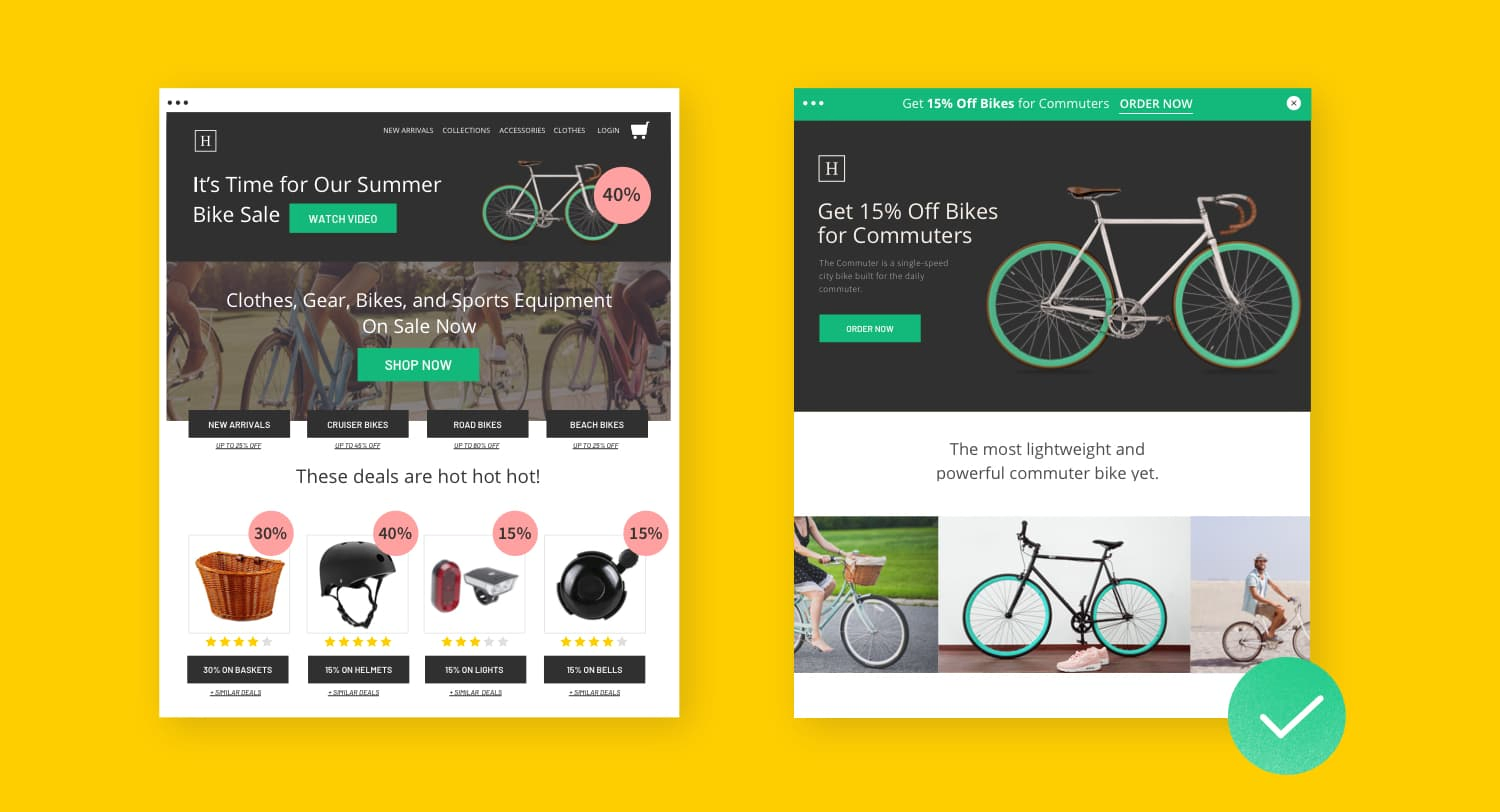
While the homepage has dozens of potential distractions—you can basically call ’em “leaks” instead of links—the landing page is super focused. Having fewer links on your landing page increases conversions, as there are fewer tantalizing clickables that’ll carry visitors away from the call to action. That’s why expert marketers always use a dedicated landing page as the destination of their traffic.
Sure, the homepage looks amazing. It shows off the brand, lets people explore a range of products, and offers additional info about the company and its values. From here, a visitor can go anywhere—apply for a job, read some press releases, review the terms of service, post on the community boards, etc.
But they won’t necessarily make a purchase. And that’s the point.
The landing page for this customer serves a completely different purpose. Paired with super slick ads that promote a single offer, everything about it works hard to turn these visitors into customers. It’s doing a better job to convert the traffic the brand’s already getting. That’s the power of landing pages!
Have another question about landing pages?
We hear ya. Here’s three questions people often ask us:
1. What do I need to include on my landing pages?
2. Landing Page vs Homepage: What’s the difference
3. What’s the best way to get started creating a landing page?
Q. Why not just pay to increase my traffic?
Running ads or email campaigns gets costly and search engine optimization can take a very long time. By using landing pages, you’ll convert more of your existing visitors and stretch those all-important resources (money and time, we mean) further.
Types of Landing Pages
You’ll see a lot of variation out there, depending on the specifics of the business, but there are really two archetypal landing page (defined by their goals):
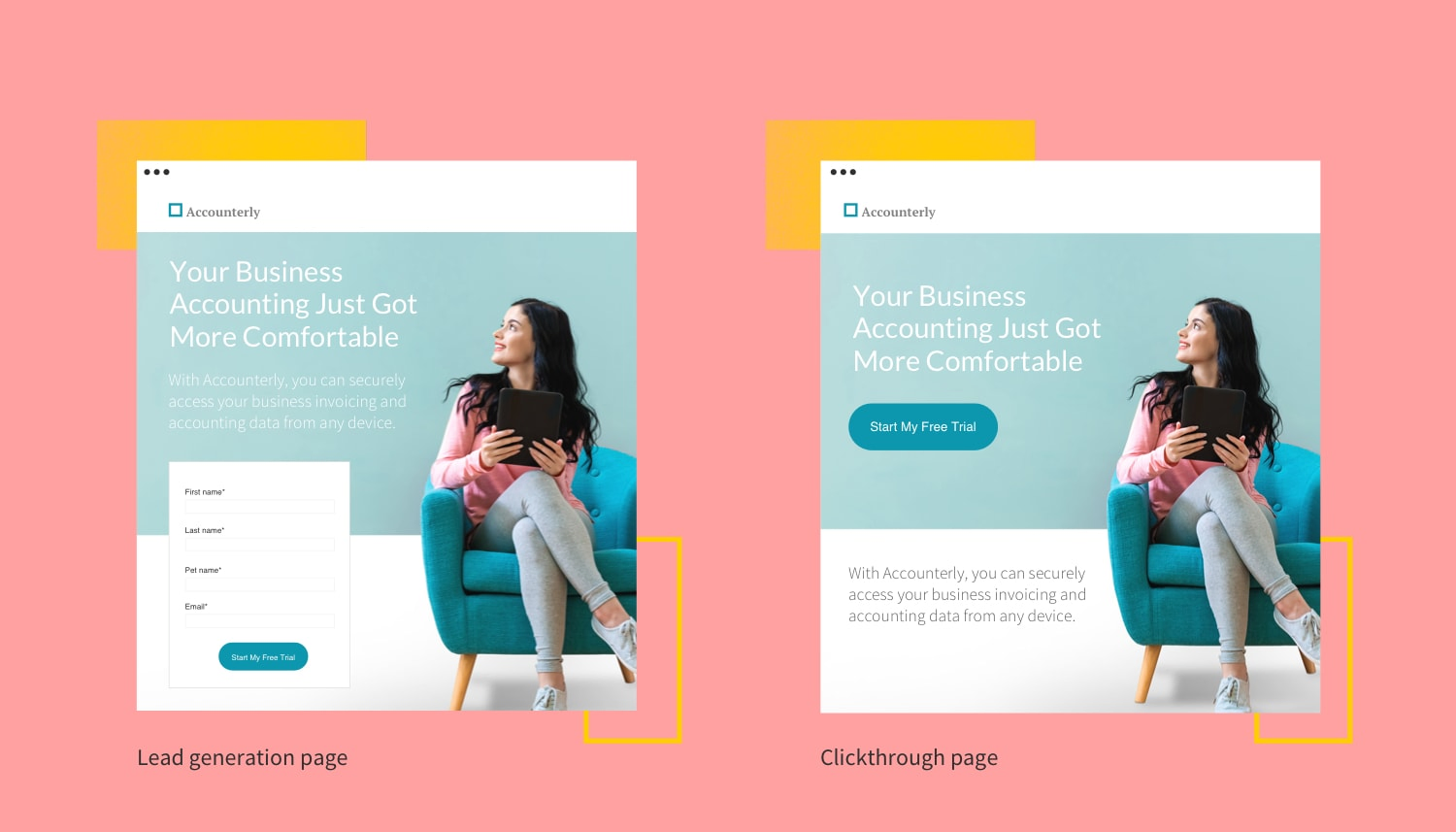
Lead Generation Landing Pages: Also called “lead gen” or “lead capture” pages, these use a form as their call to action. This form almost always collects lead data, like the names and email addresses of visitors. (You can read some expert-certified lead gen strategies here.)
B2B marketers and companies selling high-ticket items use this type of landing page to build a list of prospective customers. They sometimes offering something free, like an ebook or webinar, in exchange for contact info. Ecommerce brands can also use these pages for list-building, or offering free shipping or special deals, too.
Clickthrough Landing Pages: Frequently used by ecommerce and SaaS (software-as-a-service) marketers, clickthrough pages go straight for sales or subscription. Usually, they have a simple button as the call to action that sends the visitor into the checkout flow (like the app store) or completes a transaction.
Driving Traffic to Landing Pages
You’re going to need to fill that funnel full of visitors for your landing page to work. Fortunately, you’ve got a lot of options. Let’s explore some of the more common sources of traffic to landing pages.
Paid Search Traffic
Most search engines include paid advertising. When someone looks something up (say, “cheese of the month club”) these ads appear clearly marked—but not too clearly marked—in the search results. Here’s a typical example from Google:
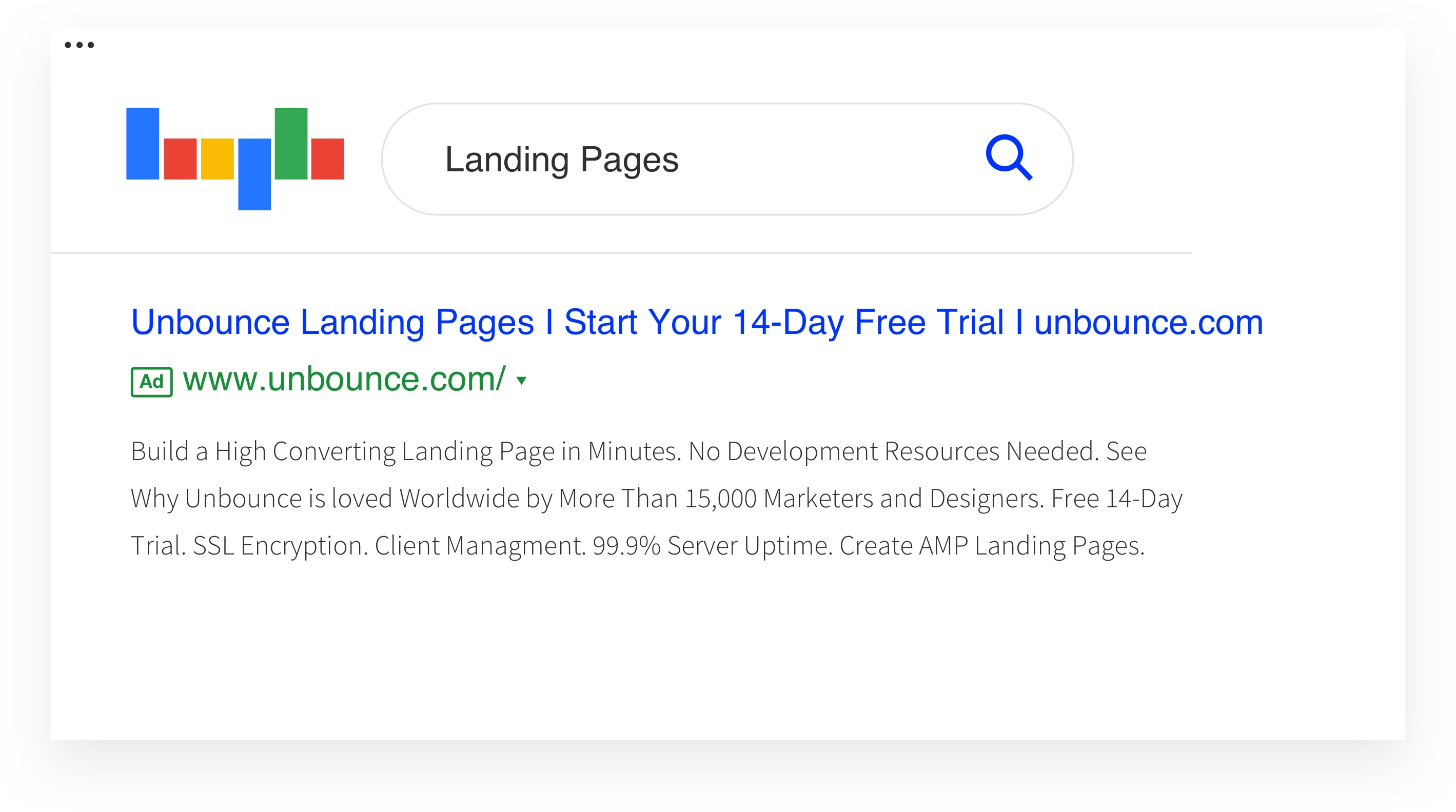
Unlike the other results on the page, pay-per-click ads are prepared and paid for by marketers. Someone who clicks will be primed by your charming copy (and, sometimes, your visuals). And you’ve likely targeted them based on their search term, demographic data, or interests revealed by their browsing history.
Crucially, when you create an ad, you get to choose where the link takes your visitor. Yes, you could choose to send them to your homepage. But, as we’ll explore below, it’s much better to create a standalone landing page that matches your ad copy and offers a clear call to action.
Paid Social Traffic
Running ads on social media sites like Facebook, Instagram, Twitter, or LinkedIn is a kickass way to target people and communities who’ll be particularly interested in your brand, regardless of whether they’re in the market yet.
Instead of people searching for “cheese of the month club,” you might advertise to people who’ve added “cheese appreciation” to their list of interests in their Facebook profile. The beauty of it is that you can connect with customers before they start to look for your product—or before they want it!
Aside from offering advanced targeting features, each social channel has its own characteristics. Instagram, for example, works well for products and lifestyle brands with a strong visual appeal. On the other hand, B2B advertisers prefer to use LinkedIn to reach professionals working in specific industries.
Email Campaigns
Email is often touted as the most effective marketing channel out there because of its enormous reach (and low costs) compared to other platforms. A 2018 study by the Radicati Group projects that there’ll be 4.2 billion email users by 2022. That’s more than half the planet!
A powerful combo of emails and landing pages can be used both to nurture existing relationships with customers and to acquire new ones. After building a list of contacts, your carefully crafted email lets you entice readers with your offer, while the landing page fills in the details and directs visitors toward a call to action.
Organic Search Traffic
The term “organic traffic” refers to any visitors who come from an unpaid source—like the bottom half of Google or Bing search results (SERPs). By creating compelling, legitimately useful content on your website or landing pages, you can ensure that your business appears more frequently in related searches. The higher your content ranks, the better.
Calling it “unpaid” is a little bit misleading, however. It doesn’t mean there isn’t time and money invested in ranking. (If only!) There’s an entire field of professionals dedicated to squeezing as much organic traffic from Google as possible through a balance of careful strategy, technical know-how, and brilliant content creation. That’s search engine optimization (SEO) in a nutshell. (Read more about SEO for landing pages here.)
Q. Are there any other channels where landing pages work?
It’s impossible to cover every use case we’ve seen. You might run native ads during a podcast, for instance, or create interactive quizzes, or run traditional print ads with QR codes. No matter how you fill the top of your funnel, a landing page will help you make the most of it.
Why Not Learn a Little Bit More?
Hey, you’ve got the fundamentals down. Now that we know what a landing page is, let’s look at the five key elements that every high-converting landing page should have.
The real question is—why wouldn’t ya?! Landing pages help increase your conversion rates and lower your cost-per-acquisition.
The main reason they’re so good at it is that promotional or product-specific landing pages are focused on a single goal. This goal matches the intent of the ad or email visitors clicked on to reach your page.
Plus, Your Website Isn’t Designed to Convert
Close your eyes and picture the homepage of a typical software company—it can be your own site, if you have one, or somebody else’s.
What do you see?
Probably many things. That’s because typically a homepage is designed with a general, exploratory purpose in mind. It speaks to brand and corporate values.
And it’s likely loaded with links and navigation to other areas, whether that’s info about your team and company, editorial content designed for search engine optimization, or other marketing materials such as press clippings, white papers, case studies, and social media feeds.
In short, there’s a lot on the typical homepage. For most businesses, it’s probably a necessary evil to have all these links. But they won’t do your conversion rates any favors.
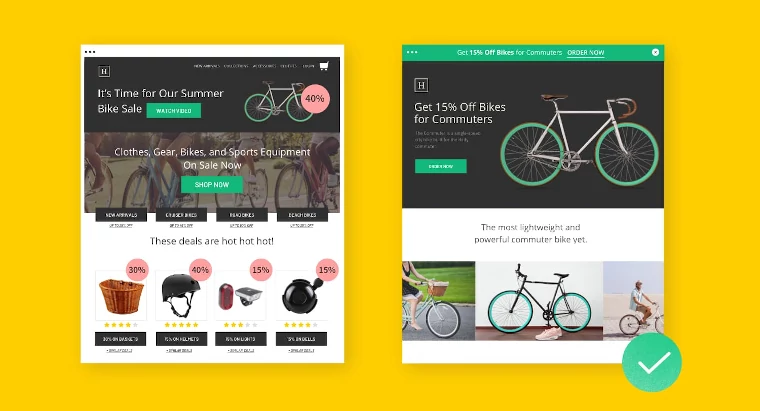
A landing page, on the other hand, has a singular purpose: converting your website’s visitors into customers or leads.
How does it accomplish this? Well, when it comes down to it, there are really two factors set landing pages apart from everything else on your site: attention ratio and message match. Let’s explore.
Attention Ratio
Every link on a page that doesn’t represent your conversion goal is a distraction that will dilute your message and reduce your conversion rate.
Attention ratio is the number of things you can do on a given webpage versus the number of things you really should be doing in order to convert.
While a homepage might have a ratio of 30:1 or higher—essentially, 30 shiny objects vying for the visitor’s attention—a successful landing page will get as close as possible to a 1:1 attention ratio.
Landing Page Navigation
The biggest culprit when it comes to creating leaks on your landing page is navigation. Whether it’s found at the top or bottom of the page, it will carry visitors away from your call-to-action and flick the invisible switch in their brains from “buy” to “explore.” For that reason, keep navigation off your landing page whenever possible.
Yes, that means your visitors won’t have a direct path to the rest of your website. But, if you want them to convert, that’s a good thing.
Q. Should I always avoid links?
If your landing page has a lot to see, it might be necessary to bend the rules a little. For instance, a long-form landing page may contain internal navigation that lets visitors jump between sections. But you can also add extra content in lightboxes so that people don’t navigate away from your pages.
Message Match
Have you ever walked into a restaurant that looked promising from the outside, only to realize that, yeeeah, you don’t actually want to eat there? (Is that a cockroach!?)
Message match is the ability of your landing page to accurately reflect the ad copy that got your visitor to the page in the first place. People leave restaurants before being seated all the time when their expectations aren’t matched, and they do this frequently on the web too.
Most visitors will leave your site within a few seconds of arrival if you don’t reinforce their mission, so it’s crucial that the buyer’s journey flows smoothly from ad to page. By ensuring a strong message match, you’re letting them know that they’ve made a “good click” and helping them along.
This example shows a comparison of good and bad message match on a landing page for a typical PPC campaign:
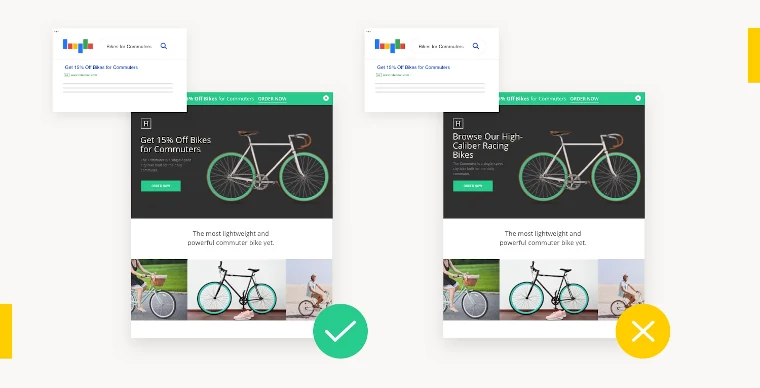
An example of bad message match
Ad: Get 50% Off Nike Air Men’s Shoes
Landing page message: Welcome to Jill’s Sporting Goods
An example of bad message match
Ad: Get 50% Off Nike Air Men’s Shoes
Landing page message: Get 50% off Nike Air at Jill’s Shoe Store
PRO TIP. Some companies don’t even bother with the whole “homepage” thing. If you’re just starting out, your offering is exceedingly simple, or you’re testing a new idea, a landing page can be an inexpensive starting point. Take a look at how to get started doing this.
Another Big Reason You Should Choose Landing Pages
It’s entirely possible to create landing pages that adhere to the rules above using your existing development resources—provided you have them.
The problem is that creating new pages on a traditional site can take a lot of time (and money) and it likely needs to be done by devs outside of your marketing team. Often, you risk ending up with something you don’t want in a timeframe that doesn’t work.
By using a AI landing page builder, like Unbounce, you can design and publish pages in a matter of hours, without the support of a development team. Drag-and-drop features and various integrations allow you to create, track, and optimize your pages for maximum impact.
And you can create promotions quickly by minimizing the lead up time.
But When Should I Use a Landing Page?
Landing pages are ideal for most inbound digital advertising campaigns. In fact, marketers have been successfully using them for over a decade to improve conversion rates and lower cost per acquisition.
Here’s a few situations when landing pages would be ideal:
- Koalified HR wants to run a pay-per-click campaign on Google Ads that targets searches related to payroll software.
- SKRT Design have created a promotion targeting subscribers to their weekly email newsletter.
- Haircore routinely advertises salon kits to young women who follow hairdressers on Instagram and Facebook.
- Eyelusions Optical uses the Google Display Network to retarget people who’ve previously visited their site without converting.
- SpringBox Mattress Co. runs native ads on a dozen lifestyle podcasts that offer discounts to listeners.
- HomeLove wants to see how interested most people are in a new expandable media table before they go to market with it.
In each case, a series of targeted landing page helps these (completely fictional) companies make the most of ad budget or their email marketing by delivering the right message to the right prospects.
PRO TIP. Building ads and landing pages for every possible Google search can demand a lot of your time. Use Dynamic Keyword Insertion in Google Ads and Unbounce’s Dynamic Text Replacement feature to personalize for many different search queries.
Segmented Promotional Offers
Not all promos are for all people. If you need to communicate to various types of customers, then the simplest way is with separate landing pages. For example, you might create pages for people who’ve signed up for your free trial versus those on your top tier plan. You’ll adjust copy, design, and the offer itself to match.
Multiple Products
Landing pages are ideal for merchants and ecommerce marketers who have more than one SKU on the go. Even when they’ve only got a single product offering, there might be multiple contexts better represented on separate pages. (“It slices! It dices! It does your taxes!” That’s at least two landing pages.)
Multiple Traffic Sources
If you run a campaign across a range of channels, creating landing pages with messaging that matches the source is a must. The captivating visuals you run on Instagram, for instance, may benefit from a different headline, hero, copy, or call to action than text-based search ads.
We’ve Got Some Secrets to Converting More
Now you know why and when to use landing pages. But don’t know where to begin? Take a look at the best practices for building high-converting landing pages with Unbounce, or browse some templates to get you started.
![[Build – MOFU] Landing Page Templates – V1 – 2024 landing page templates](https://unbounce.com/photos/blog-visual-cta-2x-v2.jpg)